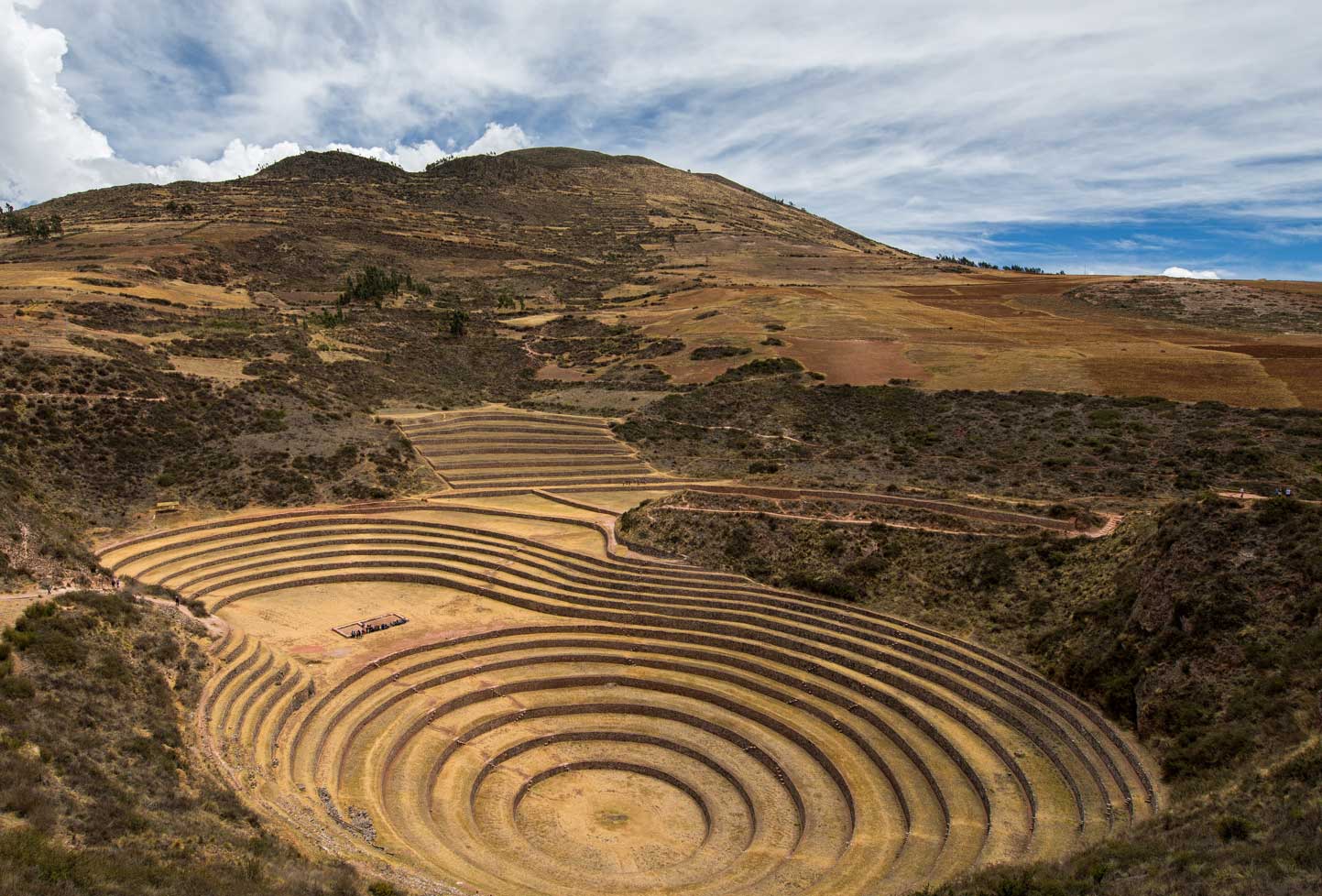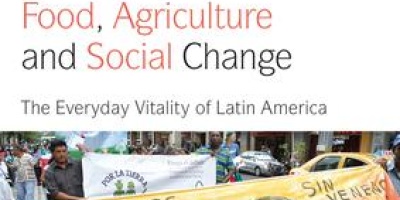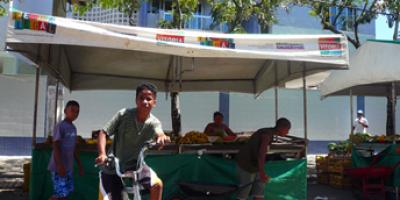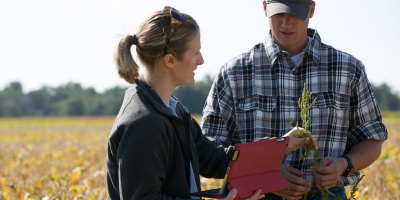In this piece, FCRN's communications and network development officer Marie Persson introduces a new regional forum. Thanks to Carlos Gonzales Fischer for input on forum topics and Sarah Najera for assistance with planning and execution of the forum .

You can join a new round of discussions in the forum between 13th October and 17 November 2016.
The FCRN recently set up a regional forum for moderated discussions on food systems and sustainability for members in Latin America and now we want to present the translated main messages in English for the wider FCRN network. We hope this will give the whole FCRN community a sense of the food sustainability related priority issues and opportunities in Latin America. For those of you who understand Spanish you can of course read the complete discussions and review the list of resources that were shared (some in Spanish) as background reading and by participants.
We welcome your comments and questions below. While some forum participants will be able to follow the comments in English, we might translate some contributions and questions made here to Spanish and share them with all forum participants.
We welcome you to join this forum if you speak Spanish and want to contribute in the upcoming forum discussions (see this invitation in Spanish for more information and information on how to sign up here).
The forum participants discussed the following topics consecutively, over seven weeks:
- Traditional versus industrial agriculture
- Sustainable consumption/diets and policies to promote these
- Livestock and soy production
- Sustainable agricultural practices and climate-smart agriculture
- Food losses and waste
- Information exchange, support and potential for collaboration.
1. Our first question focused on the relationship between traditional agricultural practices and industrial agriculture.
 We wanted to know what the forum members saw as the role, benefit and challenge or risk of each of these practices in improving food security. In particular, we were interested in hearing about their experiences and views on the effects of these practices (and knowledge systems) on food security as well as on biodiversity and other areas of concern. We asked if the dichotomy between ‘large scale industrial’ versus ‘smallscale agro-ecological’ actually holds or if it is too simplistic in the Latin American context. Below are some of the messages and arguments from the discussion. Note that not all forum participants will have subscribed to the points highlighted and all we have done here is translate the discussion, without comment or analysis:
We wanted to know what the forum members saw as the role, benefit and challenge or risk of each of these practices in improving food security. In particular, we were interested in hearing about their experiences and views on the effects of these practices (and knowledge systems) on food security as well as on biodiversity and other areas of concern. We asked if the dichotomy between ‘large scale industrial’ versus ‘smallscale agro-ecological’ actually holds or if it is too simplistic in the Latin American context. Below are some of the messages and arguments from the discussion. Note that not all forum participants will have subscribed to the points highlighted and all we have done here is translate the discussion, without comment or analysis:
a. It was argued that the two systems fulfil different and to some extent complementary roles in Latin America. Rural populations are dependent on smaller scale (not always agro-ecological) production and their products may also reach larger local markets and assist in feeding urban populations, while industrial agriculture can provide larger cities with food and provides supplies for food industry (processed foods and feed for animals). Some argued that these are not opposing systems and that either can be given the agro-ecological label, while others argued that because of the difference in scale and different “values” associated with the two systems, the small-scale system was very different and had less harmful environmental impacts.
b. There are examples where the industrialised systems are better positioned to contribute to climate mitigation because of their greater access to technologies (e.g. for rice production in Colombia and Nicaragua where laser levellers are used). But even though small-scale practices do not always follow agro-ecological principles and large scale is not always industrial and heavily input-dependent, these systems may be seen as dichotomous in terms of access to credit, land tenure and access to agricultural technical services. Many pointed to this difference between the systems and the challenges facing small-scale production both in terms of financial and market impediments (access to credits, infrastructure as well as intermediaries). (NB. a detailed discussion on how to define agro-ecology and its relationship with environmental objectives is potentially a subject for another forum - comments on this idea are welcome).
c. People felt that the challenge of implementing the agro-ecological model is to orient it towards the reviving and preserving local peasant and indigenous knowledge and cultures and there is a need to unite anthropological and agro-ecological knowledge. This reorientation will be critical to building a new participatory model for rural development which is anchored in local actors and resources. If successful, this could lead to further agro-ecological innovations as well as a new valuation of the peasants and indigenous people’s cultural territories.
d. One commentator described that there is a conceptual problem with the sustainable food production discussion, because in Latin America agricultural discourse and policy is dominantly focused on increasing production. There is very little support for integrated practices, organic farming or agroforestry (sometimes isolated policies are launched, but they never quite gain ground). Intensive food production is not beneficial for conservation and it has led to environmentally invasive monocultures, industrial crops, use of agrochemicals and so forth. (Pineapple and palm-oil production in Costa Rica were given as examples). Policies have also discouraged systems of production that integrate different productive activities on the same farm, and a promise of higher volumes being rewarded by the market, although this has not happened to the extent that was expected.
e. From a poverty and food security perspective, agro-ecology was perceived by many to be part of the solution and agroforestry was also highlighted by local Central America communities as an option with great potential. Others pointed to the importance of ecosystem-based adaptation as a means to reach food security and resilience. Public policies aimed at creating resilient production systems were mentioned as critical for food security and food sovereignty, and for adaptation to climate change. To achieve synergies between agriculture, conservation, adaptation and food security there needs to be a recognition of both the ecological and economic benefits of biodiversity.
f. Another commentator described how the two systems clearly have different goals and that there is an optimal relationship between them. For small-scale agriculture, the goals were defined to be: diversification in agroforestry production (e.g. via agroforestry models or mixed cultivation); reducing costs for fertilization and phytosanitary control; recovery of native or local products as a means to restore diversity, improve local food security and generate income by adding value and accessing specialized export markets; improving skills and human development organization for marketing local products, adaptation to climate change, project or development plans. For the industrialized system, the goals are to: move away from a paradigm where green revolution approaches are synonymous with competitiveness; rationalise and optimise use of natural resources through increased use of technology; identify markets or processing alternatives for the products of industrial systems that do not meet quality standards (and end up competing with small-scale agriculture); capacity building; use of agro-climatic information; adaptation to climate change. To make the two work together it would be necessary to ensure that they are both profitable, either via the use of marketing channels and export facilitation to promote local value-added products.
g. A recurring point that came up is that there is not enough support from governments to assist various actors in the food production with building capacity and competitiveness. Participants highlighted the importance of improving skills as well as marketing of local products, and adaptation to climate change, project or development plans.
2: Sustainable diets and the issue of meat consumption.

In this second forum discussion we asked how issues on food and the environment are being integrated in discussions on sustainable food systems in the region, in particular if there is a discussion around demand-side approaches and reducing meat consumption - or if it is mainly on agricultural production. We also asked forum members what they saw as the main challenges for shifting attention towards sustainable healthy diets in their own contexts.
a. Three countries seem to explicitly address environment and nutrition together via food policies - Colombia, Bolivia and Peru. In most countries different sections of government (and civil society) were addressing different aspects of the sustainable healthy diets concept, but it was not being done in an integrated way. Many argued that research and actions that integrate "healthy diets" and "sustainability" are very much needed. One commentator mentioned however that while some written policies and guidelines do exist, the problem lies in the effective implementation of these and so focus needs to be placed on good governance.
b. It was also mentioned that even international organisations operating in the region and working with sustainability in agri-food systems do not address the issue of sustainable food from the consumption perspective. International organisations were also said to be very reluctant to discuss reductions in meat consumption, and often emphasise livestock production efficiency as a cornerstone of food security.
c. Some then argued that is very important to recognise that there is no global blueprint for a sustainable diet that works in all contexts, that a sustainable healthy diet will also need to include culturally and ‘territorially’ appropriate products and that taking into account the geographical region as well as the social, economic and cultural aspects are essential and the best way to promote sustainability.
d. Most Latin American countries (with the exception of Brazil and Colombia) do not have in place public policies to tackle the environmental impact of livestock production despite the fact that this sector causes many of the environmental problems affecting the region - due to the huge areas of land livestock occupy and their role over the last 50 years in driving deforestation of tropical and subtropical ecosystems.
Some examples of how different countries discuss sustainable diets and the meat issue:
In Colombia the dietary guidelines actually include mentions of sustainable diets, and referring to the FAO definition of such diets, they highlight the importance of diets that respect and protect biodiversity but they also mention that such diets should be culturally accepted, economically just, accessible, affordable, nutritionally adequate, harmless and healthy and that optimise the human and natural resources. In Colombia, several agriculture-focused research institutions and governmental entities have come together in a project to look at livestock as sector with potential for achieving reductions in GHG emissions and to identify or develop national guidelines that could bring livestock into national sustainable development plans. There has also been work to develop a proposal for generating a binding document on Nationally Appropriate Mitigation Actions (NAMA) in the bovine livestock sector. In addition there is the Intersectoral Commission on Food Security and Nutrition, which tries to take a more integrated approach, but it is still not focused on sustainability. The Ministry of Environment, Housing and Territorial Development also established a National Policy for Production and Consumption in 2010; this is oriented towards creating a culture of sustainable consumption and production patterns and integrates the National Cleaner Production Policy and the National Plan for Green Markets.
Costa Rica has also put forward its plans for Nationally Appropriate Mitigation Actions (NAMA) for the food and agriculture area, and activities are being implemented in the areas of livestock and coffee production.
In Bolivia and Peru there are some overarching national programs, driven by the Ministries of Health or Environment, that speak of "sustainable healthy diets" and that also emphasise the recovery of native species as key products that fulfil the function of being nutritious while also contributing to the environmental, social and economic sustainability of smallholder production. There are also ongoing discussions on how to incorporate sustainability into dietary guidelines.
In Mexico there was, according to one commentator, no adequate integration between agricultural policies and food policies and no dialogue has been initiated about this from either the governmental or the academic sector. Sustainable agricultural practices such as organic agriculture are also said to be largely unknown by smallholder farmers.
In Venezuela some recent laws have created advances in the way public policies are oriented towards sustainable healthy diets, in particular the Agri-food Security and Sovereignty Law (la Ley Orgánica de Seguridad y Soberanía Agroalimentaria) and the Seed law (la Ley de Semillas) intended to protect seeds species that are adapted to and used in the local area.
In Argentina commentators noted that land ownership has become very concentrated since the 1990’s and that agricultural production has been monopolized by the commercial large scale sector with the implication that priorities for production are mainly decided by economic interests from these quarters.
3: The third debate focused on the issue of livestock and soy production in Latin America and their environmental impacts.
 The role of soy production in shaping agri-food sustainability was a particular focus; on whether the influence of cattle ranching as a driver of deforestation is diminishing and that of soy production increasing; and if so, what these trends imply for the environment.
The role of soy production in shaping agri-food sustainability was a particular focus; on whether the influence of cattle ranching as a driver of deforestation is diminishing and that of soy production increasing; and if so, what these trends imply for the environment.
The intensification of livestock production in Latin America is linked both to population increases and increases in income, both of which have caused a rise in demand. In Colombia, both soy and corn have transformed livestock production and food security. Soy has become a very important staple crop cultivated on the well-drained savannas (Orinoquía region) and used as animal feed with ever increasing land dedicated to its cultivation, pushing out extensive livestock farming in this region. It was noted that the soy and corn are only needed as feed inputs to intensive dairy systems, since these are the only ones that can economically justify their use. Livestock production has been displaced by other more profitable crops (with very high use of industrial inputs such as fertilizers and agrochemicals). Sugar cane and African oil palm are some of the main crops in Colombia that have driven land use changes - they are farmed on land suitable for cultivation, with pastoral livestock displaced onto environmentally constrained regions (constrained in terms of soil fertility, access to water and infrastructure and vicinity to major consumption centres).
4: The fourth discussion was on sustainable agricultural practices, and particularly climate-smart agriculture as well as information exchange for improved decision making in this area.

a. The biggest challenge lies in integrating and implementing international policies, ensuring that these are grounded in the reality of different countries and that resources are channelled to implementation and to meeting needs through concrete actions at different levels; political, technical, scientific, extension/aid and trade. It is also important that the regulations that already exists at a local level are effectively implemented.
b. Public policies that are aimed at sustainable use of land and not on maximising profits are needed and some priority areas mentioned were: family agriculture; agroecology; food and nutritional security and sovereignty; conservation of ecosystems (with a particular focus on forests and rainforest); biodiversity; ecosystem services generation, and agricultural methods focused on maximising carbon storage and preventing soil degradation. Agroecology in particular was highlighted as an important adaptation and mitigation strategy to tackle climate change. Land sharing as well as ecosystem based adaptation (mentioned above) and agroforestry were highlighted as useful methods since they promote multifunctional and resilient land use (mixed cultivation of trees, shrubs, palms, bamboos, agricultural and horticultural crops and animal husbandry). Agroforestry would also be an alternative for conservation and restoration of soil fertility, improving water infiltration, carbon sequestration, among many other ecological benefits. One commentator mentioned that emphasis should be placed on conservation of soils specifically.
c. It was mentioned that international organisations working with local and regional organisations on climate-smart agriculture programmes have developed a framework for prioritising investments in this area, which highlights the cost-benefit ratio for different practices. A compendium of practices where multiple trade-offs are evaluated has been created; it includes various solutions available in specific contexts and serves as a framework to support decision making. The initiative tries to involve stakeholders from different sectors and levels and works with pilot projects where participatory methods are used to create programmes together with local communities. However, even though many new technologies exist to improve agriculture’s resilience and reduce its negative impacts, there is a need to validate and adapt these approaches to specific contexts, and to the needs identified by local communities. Another commentator described a regional project (between Chile, Peru, Bolivia and Argentina) aimed at assisting in the creation of public policies that help adapt agriculture to climate change and mitigate its environmental impacts, and to enable farmers to return to the high Andean valleys known as the ‘Aymara country’. Factors necessary to success include: good transport systems, telephone and internet connectivity and the implementation of and access to new technologies that can assist in monitoring and mitigating the effects of climate change.
d. To ensure that sustainable agricultural practices take root, the importance of different societal actors with an interest in food systems working together was emphasised. People in schools, colleges and agriculture institutions need to be engaged in discussions and the critical role of civil society organisations, as well as religious groups in disseminating information were highlighted. By inviting extension workers and facilitators to talk about farming practices a new interest in protecting and promoting family farming can be encouraged. Even though in the climate for these discussions may be more favourable in rural areas, there is also a promising new interest in urban areas for urban community gardening.
e. It was also mentioned that the role of researchers who receive assistance from governments should primarily be to assist farmers (providing, in clear language, input to their everyday decisions) and that a much closer dialogues with farmers is needed. Technology and scientific knowledge play an important role in sustainable food production, however, their reach is currently limited to industrial agriculture, with smallholders excluded. Participants expressed a certain despair that although there are so many different initiatives discussing these issues in Latin America the influence of new research on policies and practice is very limited and that on the whole farmers are not consulted and their knowledge and experience not respected. There needs to be an increased recognition of the importance of different types of knowledge (systems) in decision making, integrating farmers’ knowledge with scientific research findings. The role of science is particularly important at the planning stage of public policy, and research projects need to be carried out jointly between researchers and the actual users of their research from the start. It was also pointed out that quality research and applied research is urgently needed to tackle the issue of adaptation in agriculture as the effects of climate change are already seen. Key is for researchers and others to produce information, that is relevant and effectively communicated to the intended audience and their needs. Communication approaches for informing policy makers, private sector entrepreneurs, farmers and scientists will again be different.
5. The topic of the fifth discussion was food waste:
 FAO estimates that 6% of the world’s food waste arises in Latin America and the Caribbean and that this region every year loses 15% of its food to landfill (despite having a population of 47 million that suffers from hunger). We asked forum participants to comment on what trends they saw in their own countries, if more country-specific evidence and data exist on food waste and what is being done to reduce food waste levels. We also asked for comments on the recent developments in Europe where supermarkets in some countries are fined if they don’t supply their waste food to charity groups, and about the merits and risks of feeding food waste to animals at a commercial scale - a practice currently banned in the EU.
FAO estimates that 6% of the world’s food waste arises in Latin America and the Caribbean and that this region every year loses 15% of its food to landfill (despite having a population of 47 million that suffers from hunger). We asked forum participants to comment on what trends they saw in their own countries, if more country-specific evidence and data exist on food waste and what is being done to reduce food waste levels. We also asked for comments on the recent developments in Europe where supermarkets in some countries are fined if they don’t supply their waste food to charity groups, and about the merits and risks of feeding food waste to animals at a commercial scale - a practice currently banned in the EU.
a. Through this discussion it became apparent that waste occurred at all stages of food production and distribution. The drivers of waste differed depending on the type of producer and depending on location; it can be a lack of material resources, financial resources, or simply overabundance of food or casual attitudes towards waste that are the decisive factors. Farming practices (including farm selection of products during harvest) together with a lack of efficient coordination between producers, distributors and sellers were important contributors to food waste. The contributing factors are thus multiple and vary according to the development stage of the individual country. In most countries there are no laws prohibiting the use of food waste to feed farm animals, although some participants said they thought regulations existed for large scale livestock production, both to ensure animal health and the health and safety of consumers. However, there was little discussion about current measures to reduce food loss and waste either at the policy or personal level. It seems the issue, while recognized as a big problem, is seldom addressed in practice.
Specific country examples:
Colombia: Food losses and waste arise at every stage of the food chain, from production through to distribution and consumption. Small sized produce with non-standard shapes or produce that may have endured mechanical damage during harvest are systematically thrown away. Slow transport (due to lacking infrastructure) together with the absence of technologies such as refrigerated trucks or proper packaging are one of the main contributors to food waste. The solution proposed by participants is a closer collaboration among all actors of the food chain.
Mexico: Mexico follows the global average, with around 30% of the food produced being wasted or discarded - every year the amount of food wasted in the country could feed 12 million people. One main contributor is the fact that food prices do not correspond to the average purchasing power in the country. This leads to a lot of unsold food being discarded by the producers and retailers - what is sold, is at a high price to consumers who can afford it and this is enough to make the business profitable. Mexican participants highlighted that efforts to address waste are directed at the production stage without support for other stages of the food industry.
Costa Rica: There is a lack of planning to reduce food waste. It seems to be an issue that is not addressed within the practices of the food industry. However, there seems to be an increased awareness of the problem and more households actively try to reduce it.
6. Information, support and collaboration:
 In this discussion we tried to look ahead and explore what the information needs are, how information is being used and how it should be communicated to have maximum impact. We also asked what the main challenges are that people encounter in their work and sector, and lastly what type of regional collaborations they would welcome with other people in the forum and with the FCRN. We asked how forum members would like to see this group collaborate in the future and what role the FCRN could play in facilitating this.
In this discussion we tried to look ahead and explore what the information needs are, how information is being used and how it should be communicated to have maximum impact. We also asked what the main challenges are that people encounter in their work and sector, and lastly what type of regional collaborations they would welcome with other people in the forum and with the FCRN. We asked how forum members would like to see this group collaborate in the future and what role the FCRN could play in facilitating this.
a. The main issues identified were the lack of political will and implementation of public policies oriented to the agricultural sector (mainly small scale producers and rural populations) as well as a lack of economic resources. Some also mentioned lack of information and data as obstacles to creating useful policies and action.
b. Creating open spaces for dialogue between farmers and others with a stake in sustainable food security was seen as a good start, but it was also mentioned that it is important to be ambitious and try to go further than merely discussion, to also create practical plans and projects.
c. An interest in forming a closer collaboration and alliance between the forum members was expressed, as a way to form a regional network focused on sustainable food systems (currently mainly national networks exist in the region to tackle these issues). It was also mentioned that further discussions in this type of online forum as well as video-conferences/webinars would be very welcome as a way of continuing the exchanges. One practical idea that was proposed was that of creating a joint proposal to seek economic support to carry out a regionally focused project.











Post a new comment »